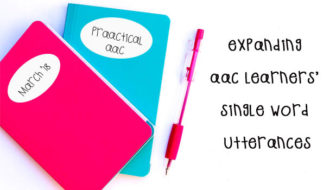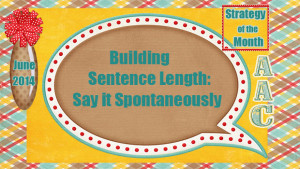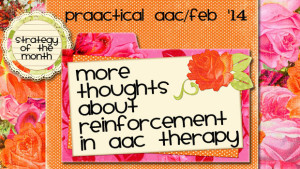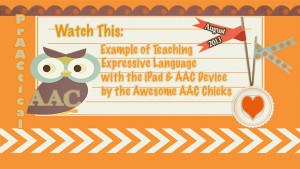March 5, 2018
by Carole Zangari -

Know any learners like these? Jacob takes his teacher over to the snack cupboard and uses his SGD to say ‘cracker.’ Mara watches her friend throw a book and signs ‘angry.’ Elisheva finishes her drink and uses a communication book to say ‘more’ Some AAC learners linger at the single word level for far longer than they need to. One of the strategies that we use to help them move forward is to expand on their utterance and build on their word to model a 2-word sentence. ‘Cracker’ becomes ‘Want cracker.’ ‘Angry’ is built into ‘Shoshana’s angry.’ ‘More’ turns into ‘more milk.’ Sounds simple, right? Well, the concept certainly is, but it’s easy to get stuck or draw a blank when trying to do these sorts of expansions in therapy sessions, classroom activities, or daily routines. If you find your team forgetting to expand the learners’ single word utterances, some examples... [Read More...]
Filed under: Featured Posts, PrAACtical Thinking
Tagged With: expansions, language intervention
June 9, 2014
by Robin Parker -

As beginning communicators start using single symbols to communicate, the next step immediately becomes to expand sentence length to two words, then three words, then more. Helping learners to use longer sentences spontaneously is the main goal. Teaching spontaneous use of longer sentences helps assure that those sentences can be used with many communication partners and in many contexts. A great facilitator strategy for helping to build sentences is ‘add a word’ or expansions and extensions. This was mentioned in last week’s post: Helping Beginning Communicators Expand Their Sentence Length but is further delineated below. What is it? ‘Add a word’ strategy is more formally called expansions and extensions. Expansions typically refer to adding a word with new conceptual knowledge while extensions add a word with new grammatical information. Expansions and extensions are a form of modeling and can be done both on a communication display as well as verbally. This... [Read More...]
Filed under: Strategy of the Month
Tagged With: expansions, extensions, Language facilitation strategies
February 17, 2014
by Carole Zangari -

When we’re teaching AAC, our preferred means of responding to learners is with natural consequences, expansions, extensions, and verbal encouragement. Here are some of our prAACtical thoughts. Natural Consequences Nothing says ‘power’ like having someone respond based on what you just said. SLPs are quite familiar with this concept and use this regularly to provide ‘more’ tickles, crackers, and music. When we work with beginning communicators, we’re all about providing quick access to whatever the AAC learner requests. But we tend to lose sight of the need for natural consequences when working with learners on higher level language skills. True, it is more difficult to think of the natural consequence when we’re working on morphology, syntax, and semantics, but the principle is the same: Learning is enhanced when our responses are driven by the message that our client just produced. We’re working with Antonio to reduce ambiguity in his messages.... [Read More...]
Filed under: Strategy of the Month
Tagged With: encouragement, expansions, extensions, natural consequence, reinforcement, token board
August 20, 2013
by Robin Parker -

Here is authentic AAC teaching by the AAC Chicks. Watch for the combined use of AAC language facilitation strategies. Can you see: aided language input, wait & signal/time delay prompt, specific reinforcement, expansions, scaffolding, modeling, and more. Also, for the SLP’s, notice the data collection that does not distract from the session.
Filed under: PrAACtical Thinking
Tagged With: aided language input, example, expansions, resources, wait & signal



